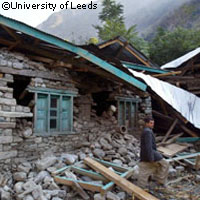Scientists to build 'self-healing' house for earthquake protection
To build an intelligent high-tech villa that can resist earthquakes by 'self-healing' cracks in its own walls and monitoring vibrations through sensors is the goal of the new EU funded project Intelligent Safe and Secure Buildings (ISSB). The project will develop special walls with 'self-healing' properties made of nano polymer particles which turn into a liquid when squeezed under pressure. The liquid will then flow into the cracks, and harden to form a solid material. The NanoManufacturing Institute (NMI), based at Leeds University, UK, is playing a key role in the €14 million project, the aim of which is to construct the intelligent regenerative home on a Greek mountainside by December 2010. The project's coordinator, Professor Terry Wilkins from the NMI, explained: 'What we're trying to achieve here is very exciting; we're looking to use polymers in much tougher situations than ever before on a larger scale.' The 'self-healing' polymers will be made thanks to nanotechnology, which involves making things on a tiny scale - less than one-hundred thousandth the width of a human hair. If the experiment proves successful, more earthquake-resistant homes could be built in danger zones known for their seismic activity across the globe. The project will first build the walls of the house from novel load-bearing steel frames and high-strength gypsum board. The second novelty will be the insertion of wireless, battery-less sensors and radio frequency identity (RFID) tags into these walls to collect large amounts of data on the stresses and vibrations, temperature, humidity and gas levels affecting the building. If a problem such as an earthquake should occur, the intelligent sensor network will alert residents immediately, giving them time to escape to safety. Professor Wilkins added: 'If whole groups of houses are so constructed, we could use a larger network of sensors to get even more information. Then if the house falls down, we have got hand-held devices that can be used over the rubble to pick out where the embedded sensors are hidden to get information about how the villa collapsed and about anyone who may be around, so it potentially becomes a tool for rescue.' Dr Roger Gregory, a partner involved in the potentially life-saving project, said: 'Leeds are world leaders in designing wireless networks for extreme environments and hard-to-access places. Even if the building totally collapsed, the sensors would still let you pinpoint the source of the fault.' Professor Wilkins concluded: 'Once we have the optimum design, we could quickly start producing thousands of litres of nanoparticle fluid, adding just a tiny percentage to the gypsum mix.'
Countries
United Kingdom



